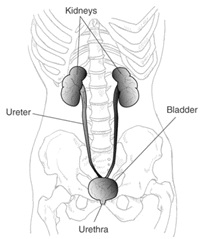Kidney Stones
A kidney stone is a solid or hard mass made up of tiny crystals that separate from the urine within the urinary tract. Normally, urine contains chemicals that prevent or inhibit the crystals from forming. One or more stones can be in the kidney or ureter at the same time. If the crystals remain tiny enough and most do, they will travel through the urinary tract and pass out of the body in the urine without being noticed and without any intervention by a physician.
Kidney stones may contain various combinations of chemicals. The most common type of stone contains calcium in combination with either oxalate or phosphate. These chemicals are part of a person's normal diet and make up important parts of the body, such as bones and muscles.
Kidney stones may not produce symptoms until they begin to move down the tubes (ureters) through which urine empties into the bladder. When this happens, the stones can block the flow of urine out of the kidneys. This causes swelling of the kidney or kidneys, causing pain. The pain is usually severe.
Stones that cause lasting symptoms or other complications may be treated by various techniques, most of which do not involve major surgery.
Introduction to the Urinary Tract
The urinary tract, or system, consists of the kidneys, ureters, bladder, and urethra. The kidneys are two bean-shaped organs located below the ribs toward the middle of the back, one on each side of the spine. The kidneys remove extra water and wastes from the blood, producing urine. They also keep a stable balance of salts and other substances in the blood. The kidneys produce hormones that help build strong bones and form red blood cells.

Narrow tubes called ureters carry urine from the kidneys to the bladder, an oval-shaped chamber in the lower abdomen. Like a balloon, the bladder's elastic walls stretch and expand to store urine. They flatten together when urine is emptied through the urethra to outside the body.
Causes And Types of Kidney Stones
Kidney stones can form when urine contains too much of certain substances. The biggest risk factor for kidney stones is dehydration.
Kidney stones are common. A person who has had kidney stones often gets them again in the future. Kidney stones often occur in premature infants. Some types of stones tend to run in families. Certain kinds of stones can occur with bowel disease, ileal bypass for obesity, or renal tubule defects.
There are different types of kidney stones. The exact cause depends on the type of stone.
- Calcium stones are most common occurring more often in men than in women, and usually appearing between ages 20 - 30. They are likely to come back. Calcium can combine with other substances, such as oxalate (the most common substance), phosphate, or carbonate to form the stone. Oxalate is present in certain foods. Diseases of the small intestine increase the risk of forming calcium oxalate stones.
- Cystine stones can form in people who have cystinuria, a disorder running in families and affecting both men and women.
- Struvite stones are mostly found in women who have a urinary tract infection. These stones can grow very large and block the kidney, ureter or bladder.
- Uric acid stones are more common in men than in women. They can occur with gout or chemotherapy.
Symptoms
The main symptom is severe pain that starts suddenly and may go away suddenly. It may be felt in the belly area, side of the back, groin area or testicles.
Other symptoms can include: abnormal urine color, blood in the urine, chills, fever, nausea and/or vomiting.
Ways to Test
Tests for kidney stones include:
- Analysis of the stone to show what type it is
- Uric acid level
- Urinalysis to see crystals and red blood cells in urine
Stones or a blockage of the ureter can be seen on:
- Abdominal CT scan
- Abdominal/kidney MRI
- Abdominal X-rays
- Intravenous pyelogram (IVP)
- Kidney ultrasound
- Retrograde pyelogram
Treatment
Treatment varies depending on the type of stone and how severe the symptoms are. People with severe symptoms might need to be hospitalized. When the stone passes, the urine should be strained and the stone saved and tested to determine the type.
Drink at least six- eight glasses of water per day to produce a large amount of urine. Some people might need to get fluids through a vein (intravenous).
Pain relievers can help control the pain of passing the stones (renal colic). For severe pain, you may need to take narcotic pain killers or nonsteroidal anti-inflammatory drugs (NSAIDS) such as ibuprofen.
Depending on the type of stone, your doctor may prescribe medicine to decrease stone formation or help break down and remove the material that is causing the stone. Medications can include:
- Allopurinol (for uric acid stones)
- Antibiotics (for struvite stones)
- Diuretics
- Phosphate solutions
- Sodium bicarbonate or sodium citrate (which make the urine more alkaline)
Surgery is usually needed if:
- The stone is too large to pass on its own
- The stone is growing
- The stone is blocking urine flow and causing an infection or kidney damage
Today, most treatments are much less invasive than in the past.
- Extracorporeal shock-wave lithotripsy is used to remove stones slightly smaller than a half an inch that are located near the kidney. This method uses ultrasonic waves or shock waves to break up stones. Then, the stones leave the body in the urine.
- Percutaneous nephrolithotomy is used for large stones in or near the kidney, or when the kidneys or surrounding areas are incorrectly formed. The stone is removed with an endoscope that is inserted into the kidney through a small opening.
- Ureteroscopy may be used for stones in the lower urinary tract.
- Standard open surgery (nephrolithotomy) may be needed if other methods do not work or are not possible.
Prevention
If you have a history of stones, drink plenty of fluids (six - eight glasses of water per day) to produce enough urine. Depending on the type of stone, you might need to take medications or other measures to prevent the stones from returning.
You may need to change your diet to prevent some types of stones from coming back. People prone to forming calcium oxalate stones may be asked by their doctor to limit or avoid certain foods if their urine contains an excess of oxalate.
High-oxalate foods - higher to lower
- rhubarb
- spinach
- beets
- Swiss chard
- wheat germ
- soybean crackers
- peanuts
- okra
- chocolate
- black Indian tea
- sweet potatoes
Foods that have medium amounts of oxalate may be eaten in limited amounts.
Medium-oxalate foods - higher to lower
- grits
- grapes
- celery
- green pepper
- red raspberries
- fruit cake
- strawberries
- marmalade
- liver
Who Gets Kidney Stones?
For unknown reasons, the number of people in the United States with kidney stones has been increasing over the past 30 years. In the late 1970s, less than four percent of the population had stone-forming disease. By the early 1990s, the portion of the population with the disease had increased to more than five percent. Caucasians are more prone to develop kidney stones than African Americans. Stones occur more frequently in men. The prevalence of kidney stones rises dramatically as men enter their 40s and continues to rise into their 70s. For women, the prevalence of kidney stones peaks in their 50s and once a person gets more than one stone, more are likely to develop.





